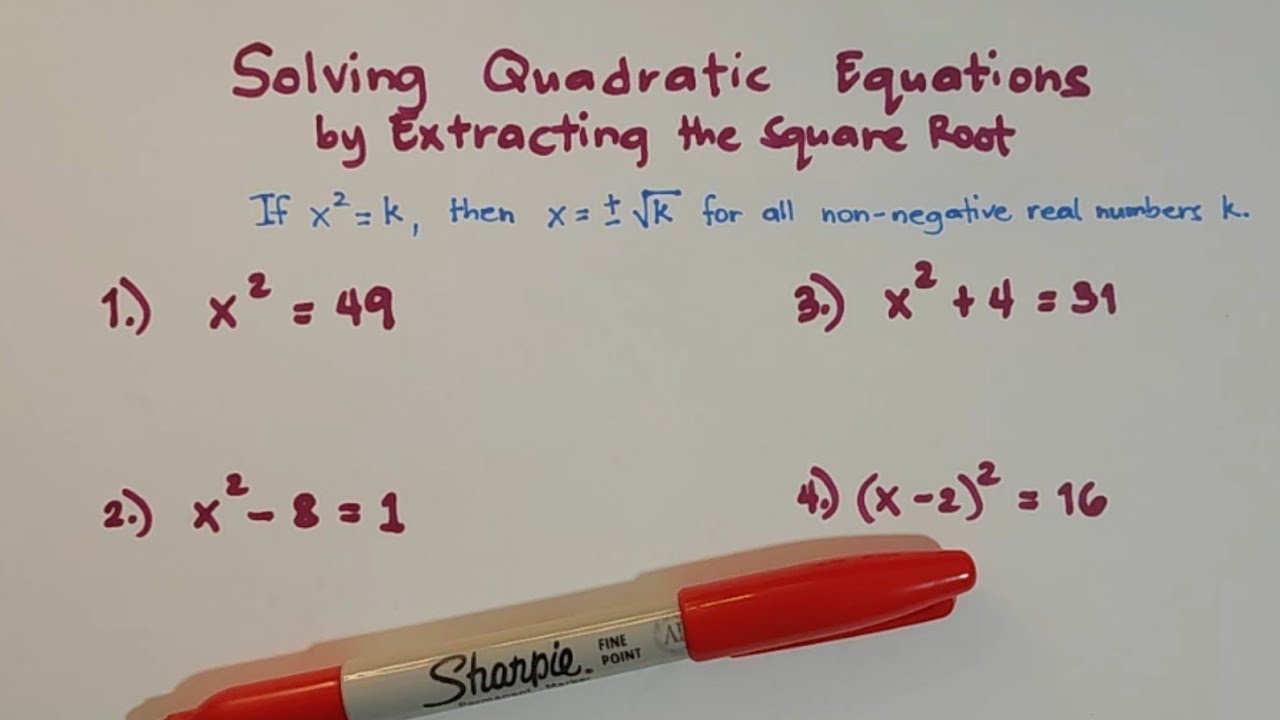PERSAMAAN KUADRAT part ZERO-ONE
Summary
TLDRThis video tutorial explains how to solve quadratic equations using three methods: factorization, completing the square, and the quadratic formula. The instructor demonstrates each technique with the example equation x² + 4x - 5 = 0, providing step-by-step guidance. The video also covers key concepts like roots, discriminants, and graphing quadratic functions. Viewers learn how to identify the roots of an equation, calculate the discriminant, and graph the resulting quadratic function, forming a parabola. The tutorial offers practical tips and clarifies common points of confusion in solving quadratic equations.
Takeaways
- 😀 Quadratic equations have a degree of 2, meaning the highest exponent of the variable is squared, e.g., x² + 4x - 5 = 0.
- 😀 There are three main methods for solving quadratic equations: factorization, completing the square, and using the quadratic formula (abc formula).
- 😀 Factorization involves finding two numbers whose sum equals the coefficient of x and whose product equals the constant term.
- 😀 Completing the square transforms a quadratic equation into a perfect square form, allowing for easy root calculation, leading to solutions of x + 2 = ±3.
- 😀 The quadratic formula is used when factorization or completing the square is difficult; it is written as x = [-b ± √(b² - 4ac)] / 2a.
- 😀 The solutions to the quadratic equation x² + 4x - 5 = 0 using the three methods are x₁ = -5 and x₂ = 1.
- 😀 The discriminant (D = b² - 4ac) helps determine the number of real solutions; if D > 0, there are two real roots, if D = 0, there's one real root, and if D < 0, there are no real solutions.
- 😀 The sum of the roots (x₁ + x₂) of a quadratic equation can be calculated using the formula -b/a, while the product of the roots (x₁ * x₂) can be calculated as c/a.
- 😀 When performing arithmetic operations on the roots of a quadratic equation, always remember that x₁ should be smaller than x₂ to avoid errors in subtraction.
- 😀 Graphing a quadratic function creates a parabola, with key points including the x-intercepts (roots), y-intercept, and vertex.
- 😀 To graph a quadratic equation, plot points from a function table and connect them to form the parabolic shape, with the vertex as the turning point of the graph.
Q & A
What is a quadratic equation?
-A quadratic equation is a type of mathematical equation in which the highest degree of the variable is 2. An example is x² + 4x - 5 = 0.
What are the three methods for solving a quadratic equation?
-The three methods for solving a quadratic equation are: 1) Factorization, 2) Completing the square, and 3) Using the quadratic formula (ABC formula).
How can the quadratic equation x² + 4x - 5 = 0 be factored?
-The quadratic equation x² + 4x - 5 = 0 can be factored as (x + 5)(x - 1) = 0.
What are the solutions (roots) of the equation x² + 4x - 5 = 0 using the factorization method?
-The solutions are x₁ = -5 and x₂ = 1, derived from the factors (x + 5) = 0 and (x - 1) = 0.
How is completing the square applied to solve the quadratic equation?
-To complete the square, the equation is rewritten in the form (x + 2)² = 9, leading to the solutions x₁ = -5 and x₂ = 1.
How does the quadratic formula work to solve a quadratic equation?
-The quadratic formula is x = [-b ± √(b² - 4ac)] / 2a. For the equation x² + 4x - 5 = 0, this gives the solutions x₁ = -5 and x₂ = 1.
What is the discriminant in a quadratic equation, and how is it used?
-The discriminant is the part under the square root in the quadratic formula, b² - 4ac. It determines the nature of the roots (real or complex). For the equation x² + 4x - 5 = 0, the discriminant is 36.
What does the value of the discriminant tell us about the solutions?
-A discriminant greater than 0 indicates two distinct real roots. For the equation x² + 4x - 5 = 0, the discriminant is 36, meaning there are two real solutions.
What is the relationship between the quadratic equation and its graph?
-The graph of a quadratic equation is a parabola. The solutions (roots) are the x-intercepts where the graph intersects the x-axis.
How can the vertex (or turning point) of a parabola be calculated?
-The vertex can be found using the formula x = -b / 2a. For the equation x² + 4x - 5 = 0, the vertex is at x = -2.
Outlines

This section is available to paid users only. Please upgrade to access this part.
Upgrade NowMindmap

This section is available to paid users only. Please upgrade to access this part.
Upgrade NowKeywords

This section is available to paid users only. Please upgrade to access this part.
Upgrade NowHighlights

This section is available to paid users only. Please upgrade to access this part.
Upgrade NowTranscripts

This section is available to paid users only. Please upgrade to access this part.
Upgrade NowBrowse More Related Video

Persamaan Kuadrat •Part 1: Menyelesaikan Persamaan Kuadrat dengan Pemfaktoran / Faktorisasi Tipe 1&2

Solving Quadratic Equations

3 Cara mudah akar akar persamaan kuadrat

Bilangan Kompleks • Part 2: Bilangan Imajiner

How to Solve Quadratic Equations by Extracting the Square Root? @MathTeacherGon

Persamaan Kuadrat Kelas 10 Kurikulum Merdeka
5.0 / 5 (0 votes)